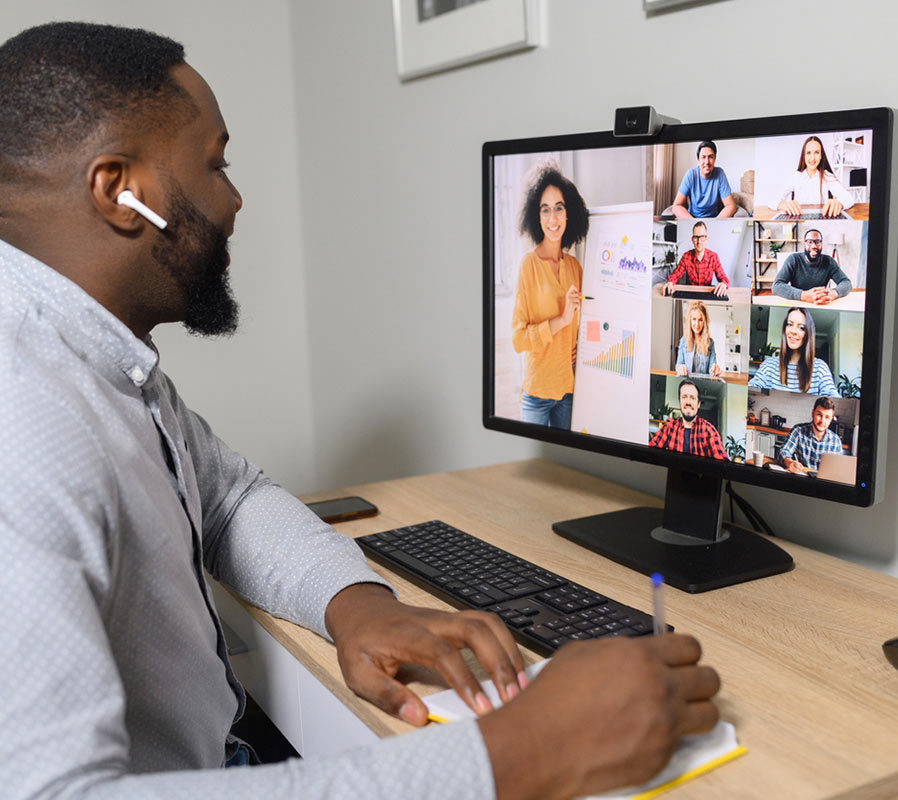Introduction
When planning a meeting or presentation, it is important to begin with an accessible and inclusive mindset. This will help prevent any potential barriers to participation. Here you will find helpful information on how to make your meetings/presentations more accessible. It outlines steps that you can follow as you prepare for and host a meeting/presentation so that all attendees can equally access and contribute to the discussions being held. By making your meetings/presentations more accessible, you will be creating a space that is welcoming, fair, and more productive.
Before the Meeting
Invitation
When you send out the invitation, make space for attendees to tell you what they need in order to fully participate in your meeting. Individuals know best what works for them. Include a message encouraging attendees to contact you if needed. Asking attendees beforehand is an easy step to help you better plan for accessible meetings/presentations.
If you are sending the invite by email, ensure that it is in an accessible format. For guidance, review the Accessible Email guide. Remember to send meeting invites well in advance to allow people time to prepare.
Venue
When selecting the location and space for your meeting/presentation, you will want to consider the venue from an accessible perspective. Make sure the space you are selecting is near accessible parking, entrances, and elevators. Also, be sure to pick a space near accessible washrooms and gender-neutral washrooms.
In terms of the actual space or meeting room you select, you will want to consider the following questions:
- Does it have adequate open space for anyone who may be using mobility aids, devices, and/or service animals?
- Is the furniture easily moveable? Does the seating meet accessibility standards?
- Does the room have built-in speakers and is there access to portable microphones for speakers?
- Does the space have good acoustics?
- Is the space well-lit? Will presenters/speakers be easily visible at the front?
- Is the room spacious enough to comfortably fit all your attendees?
Asking these questions and more during your planning process will help you think more critically and proactively about the accessibility of your meeting/presentation as a whole.
If you are planning on hosting a meeting/presentation virtually, review the Accessible Virtual Meetings guide.
During the Meeting
Materials and Technology
Share any materials with attendees in advance whenever possible. Remember to ensure your materials are accessible. The following articles outline how to create accessible Microsoft Office documents.
- Creating Accessible Excel Files
- Creating Accessible PDF Documents
- Creating Accessible PowerPoint Presentations
- Creating Accessible Word Documents
If you are using visual materials (slides, charts, etc.), make sure you are prepared to verbally describe them. For guidance, check out the Describing Visuals article. Remember to use plain and inclusive language when speaking and to define terms and any potential jargon that may be used.
If you intend to use technology during your meeting or presentation, ensure it is accessible. Are you showing captioned videos? Are interactive activities/games accessible on a screen reader? Being proactive with this information will allow you to make any necessary adjustments and changes to ensure accessibility.
Interaction
Create a comfortable, respectful, and inclusive environment. Outline the agenda and any participation expectations. Set the stage for open communication around needs. This may make attendees more comfortable, letting you know what their needs are. Start your meeting/presentation by identifying this and outline what some of your needs are as the person speaking.
Allow only one person to speak at a time and encourage attendees to raise hands if they want to speak. This will help to avoid disruption and gives everyone an equal opportunity to speak.
Be willing to work with additional support staff, like notetakers or ASL interpreters.
- Share any materials in advance to help with preparation and context.
- Position yourself and the interpreter in the attendees’ line of sight. Check in with the attendee and interpreter to ensure your positioning is appropriate.
- Speak in a clear voice with a reasonable pace, and speak directly to the attendee, not the interpreter. Remember that you are communicating with the attendee.
- Repeat questions and responses from others in the meeting so all information and dialogue is shared.
After the Meeting
Follow-up communications and materials
Once you have finished, share any follow-up communications or materials in an accessible format. If you are using a digital platform to share materials make sure it’s accessible.
Ask for feedback from your attendees
Following the meeting, it is important to assess what’s working well and what’s not working well. Ask your attendees for feedback to get ideas to improve your meeting/presentation. Being open and flexible to your attendees’ needs will assist you in creating a more productive and inclusive environment.
Summary/Key Takeaways
It is important for all of us to remember that people attending our meetings/presentations may have access needs that differ from our own. Using some of the ideas and suggestions in this article to plan, host, and facilitate your meetings/presentations will help you in creating an accessible and productive environment.



